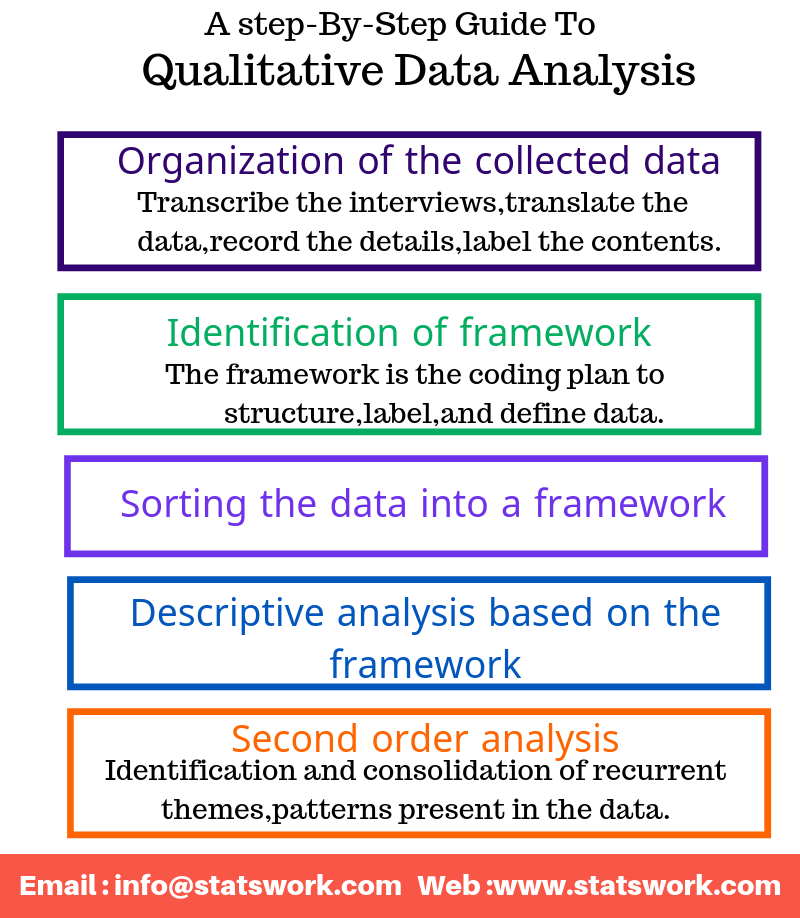

A wide range of non-quantifiable elements such as events, behaviours, activities, meanings etc. All codes need to be assigned meaningful titles. A ‘code’ can be a word or a short phrase that represents a theme or an idea. Coding can be explained as categorization of data. Qualitative data analysis can be conducted through the following three steps: Then, additional cases are examined to see if they contribute to the theory. This method of qualitative data analysis starts with an analysis of a single case to formulate a theory. This is more advanced method that consists of several stages such as familiarization, identifying a thematic framework, coding, charting, mapping and interpretation.ĥ. A method of analysis of naturally occurring talk and all types of written text.Ĥ. In other words, narrative analysis is the revision of primary qualitative data by researcher.ģ. This method involves the reformulation of stories presented by respondents taking into account context of each case and different experiences of each respondent. This refers to the process of categorizing verbal or behavioural data to classify, summarize and tabulate the data.Ģ. Qualitative data analysis can be divided into the following five categories:ġ. Charles’ work on transcription is showcased on the verbatim scripts he has published in the International Journal of Qualitative Studies, Art/Research International, the International Journal of Education & the Arts, and The Qualitative Report.Qualitative data refers to non-numeric information such as interview transcripts, notes, video and audio recordings, images and text documents. Her research interests include development of qualitative methods and methodologies, the status and future of research libraries, and the impact of the assemblage of neoliberalism, globalization, and corporatization on western higher education.Ĭharles Vanover (PhD University of Michigan) is Associate Professor in Educational Leadership at the University of South Florida. She is the author or coauthor of more than 100 chapters and journal articles on aspects of higher education or qualitative research methods and methodologies.

Lincoln is Ruth Harrington Chair of Educational Leadership Emerita and University Distinguished Professor of Higher Education Emerita at Texas A&M University, where she also served as Program Chair for the higher education program area, Associate Department Head, and Department Head. She is the author of 73 publications her research interests include higher education leadership, methodological issues in cross-language qualitative data analysis, women in higher education, and access, resilience, and retention of underrepresented students

She received her MBA from the National University of Mexico (UNAM), and a PhD from Texas A&M University (College Station). She served as Energy Fellow for the UH Energy initiative of the University of Houston. Gonzalez is Associate Professor of Higher Education in the Department of Educational Leadership and Policy Studies in the University of Houston, where she also serves as Program Director of the Higher Education PhD program.
-01.png)
Qualitative data analysis best practices how to#
There is no formula to translate culture, but the authors help us understand how to unpack the complexities of this important form of inquiry.įill in the form on the right to watch this free on-demand webinar now.Įlsa M. Lincoln provide a set of how-to’s for engaging data with a cross-cultural and cross-language origin. This on-demand webinar focuses attention on one of the most complex issues in qualitative research: analyzing data collected in one language, in this case Spanish, for publication in a second language, in this case English.īuilding on their chapter in Charles Vanover, Paul Mihas, and Johnny Saldaña’s book, Analyzing and Interpreting Qualitative Research: After the Interview, Elsa M.


 0 kommentar(er)
0 kommentar(er)
